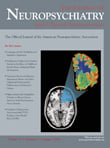Alcoholic Optic Neuropathy: Another Complication of Alcohol Abuse
To the Editor: Alcohol affects both the central and the peripheral nervous system; hence, cognitive dysfunction as well as sensory and motor peripheral neuropathy are frequent complications of chronic abuse. 1 However, symptoms of cranial nerve neuropathy are not routinely examined in alcohol abusing patients. To emphasize the necessity of such an assessment, we report on a man who abused alcohol and presented with progressive visual loss attributed to optic nerve neuropathy.
Case Report
A 55-year-old man was admitted to the clinic for alcohol detoxification. He smoked one pack of cigarettes per day for many years and heavily abused alcohol for 15 years, which he had reduced over the last 2 years. Clinical examination revealed numbness and weakness, particularly of the lower limbs, diminished tendon reflexes, and progressive painless blurring of central vision bilaterally; these symptoms, developed over the last 2 years and had seriously compromised his daily functioning. A motor and sensory nerve conduction study showed slowed motor conduction and low-amplitude response to sensory stimuli, mostly on the right. Visual fields testing revealed an infero-temporal and central defect in the right eye and a superonasal, inferior, and central defect in the left. Humphrey 10–2 static perimetry showed bilateral caecocentral scotomas. Visual acuity was 8/10 in the right and 5/10 in the left eye. Color vision was normal. Intraocular pressure was 15 mmHg in both eyes and anterior segments were normal. Funduscopy findings were unremarkable. Blood count, serum vitamin B 12 and folate levels were normal, but macrocytosis was present (MCV: 104fl.); also, transaminases were elevated. Following alcohol withdrawal and a 6-month vitamin supplementation (vitamins C, E, B complex, folate, taken both orally and intramuscularly), peripheral neuropathy considerably improved but optic neuropathy remained refractory to treatment.
Discussion
Tobacco-alcohol amblyopia was often described prior to World War II in patients with heavy tobacco and ethanol consumption. At the present time, tobacco-alcohol amblyopia is either far less common or is seldom checked for and reported. 2 – 3 It is characterized by subacute or gradual loss of central vision, decreased visual acuity, and dyschromatopsia. Fundi may appear normal, with few abnormalities on detailed examination; temporal atrophy of the optic disk may become evident at later stages. Metabolic optic neuropathies are characterized by specific loss of the nerve fiber layer in the papillomacular bundle. 2 – 4 They are etiologically distinguished from hereditary-degenerative neuropathies, neuropathies due to nutritional deficiencies (e.g., thiamine, vitamin B 12 and folic acid deficiency), and neuropathies caused by various toxic agents (e.g., ethambutol and cyanide). Impairment of mitochondrial oxidative phosphorylation has been proposed as the common underlying pathophysiological mechanism. 5
In tobacco-alcohol amblyopia, gradual accumulation of formic acid, malnutrition, thiamine depletion, poor B 12 absorption in the presence of ethanol, and a number of toxic tobacco ingredients, particularly cyanide, act synergistically to the development of neuropathy. Vitamin and nutritional deficiencies are considered especially important factors for its development and recovery is purportedly complete with abstinence from alcohol and smoking and vitamin supplementation. 3 – 5
The present case, the first reported in the literature, does not fulfill the characteristic tobacco-alcohol amblyopia criteria, in that dyschromatopsia, an essential component of tobacco-alcohol amblyopia, is absent and no recovery of vision loss was recorded following sobriety from alcohol and tobacco and protracted vitamin treatment. These findings point to the possibility of a nonreversible atypical form of optic nerve neuropathy due to alcohol abuse.
1 . McIntosh C, Chick J: Alcohol and the nervous system. J Neurol Neurosurg Psychiatry 2004; 75:iii16–21Google Scholar
2 . Behbehani R, Sergott RC, Savino PJ: Tobacco-alcohol amblyopia: a maculopathy? Br J Ophthalmol 2005; 89:1543–1544Google Scholar
3 . Kesler A, Pianka P: Toxic optic neuropathy. Curr Neurol Neurosci Rep 2003; 3:410–414Google Scholar
4 . Sadun AA: Metabolic optic neuropathies. Semin Ophthalmol 2002; 17:29–32Google Scholar
5 . Carelli V, Ross-Cisneros FN, Sadun AA: Optic nerve degeneration and mitochondrial dysfunction: genetic and acquired optic neuropathies. Neurochem Int 2002; 40:573–584Google Scholar



